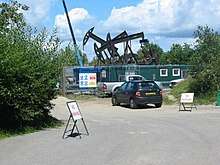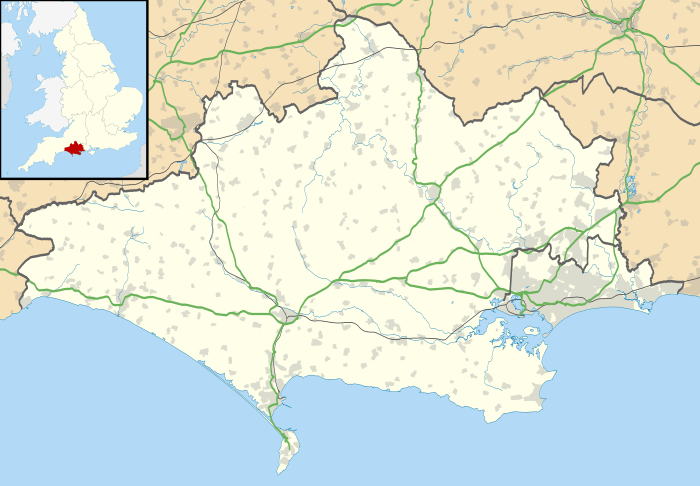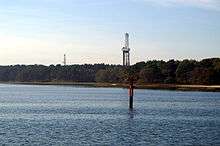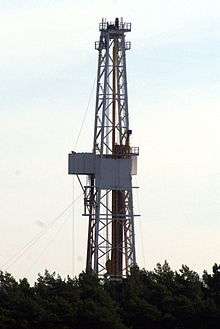Wytch Farm
Wytch Farm is an oil field and processing facility in the Purbeck district of Dorset, England. It is the largest onshore oil field in western Europe. The facility, taken over by Perenco in 2011, was previously operated by BP. It is located in a coniferous forest on Wytch Heath on the southern shore of Poole Harbour, two miles (3.2 km) north of Corfe Castle. Oil and natural gas (methane) are both exported by pipeline; liquefied petroleum gas is exported by road tanker.
| Wytch Farm | |
|---|---|
 Wytch Farm oil wells | |
 | |
| Country | England, United Kingdom |
| Location | Dorset |
| Coordinates | 50.66017°N 2.03673°W |
| Operator | Perenco |
| Field history | |
| Discovery | 1973 |
| Start of production | 1979 |
| Production | |
| Current production of oil | 13,500 barrels per day (~8.44×105 t/a) |
| Year of current production of oil | 2019 |
| Peak of production (oil) | 110,000 barrels per day (~6.9×106 t/a) |
| Estimated oil in place | 65.40 million tonnes (~ 60.78×106 m3 or 382.3 million bbl) |
| Estimated gas in place | 1.42×109 m3 (50×109 cu ft) |
History
Name
The oil field takes its name from the neighbouring Wytch Farm which had existed on the site for many centuries on the fringes of Wytch Heath.[1]
Pre-1973
The earliest industry in the Wytch Farm area dated to the early medieval period and featured multiple salt production workshops. The workshops, adjacent to the modern oilfield, were part of a medieval salt industry owned by Milton Abbey. [2] The site was excavated by Bournemouth University under the directorship of Dr Derek Pitman.[3]
The Isle of Purbeck's oil shale, or "Kimmeridge Coal" which has been won from the cliffs to the east of Kimmeridge since the early 17th century, is no longer used commercially.[4] Similar deposits were found at Wytch Farm in the 1890s,[4] but were commercially exploited until only circa 1900, and only at a low level.[4] The Kimmeridge Oil and Carbon Company reported that in 1890 it had dug 5,000 feet (1,500 m) of tunnels at Kimmeridge on four levels into the local cliffs. There was a local jetty to export the oil shale, and smaller operations occurred at nearby Bencliff Grit east of Osmington Mills.[5]
The Isle of Purbeck's oil industry began in 1936 with the first unsuccessful and then experimental wells drilled at Broad Bench near Kimmeridge by D'Arcy Exploration.[4] The area had long been mined for oil shale and tar, but was only prospected for crude oil in the 1950s.[6] It was not until 1959 that a borehole at Kimmeridge showed that oil was seeping out, and 1960 that British Petroleum's Kimmeridge Oil Field was discovered.[4]
1973 to date
The field was discovered by the nationalised British Gas Corporation in December 1973 and began producing oil in 1979. As part of the privatisation of British Gas in the 1980s, Wytch Farm was sold to BP which took over as operator in 1984.[7] In May 2011, BP announced that it had agreed to sell its majority interest in Wytch Farm to Perenco, which became the new operator.[8] Premier Oil has a 30.1% stake in the field.[9] On 17 May 2011, BP announced the sale of its interests in the Wytch Farm, Wareham, Beacon and Kimmeridge fields to Perenco[10] and the sale of the Dimlington gas terminal to Perenco in February 2011.[11] In September 2012, Perenco UK applied to Dorset County Council (DCC) for permission to extend the life of 39 planning permissions at three of the oilfields. DCC’s Planning Committee recommended approval of the applications on 6 September 2013, thereby extending to 2037 the operational life of the oilfields, beyond their original end-date of 2016.[12]
Geology
The field is located in a faulted block of Jurassic and older rocks beneath the Hampshire Basin, close to the steeply sloping monocline in the overlying chalk. The Purbeck Monocline defines the field's southern limit. The field consists of three separate reservoirs known as Bridport, Sherwood and Frome. Bridport, the first discovery, is in the Jurassic Bridport Sands 900 metres (3,000 ft) below Poole Harbour, with an oil source in the Lower Lias. The much larger Sherwood (discovered 1978) is below this in the Triassic Sherwood Sands at 1,600 metres (5,200 ft) and extends under Poole Bay. Frome is in a shelly limestone at 750 metres (2,460 ft). The field extends eastwards from Sandbanks and Studland for around 10 kilometres (6.2 mi) under the sea to the south of Bournemouth.[13]
Environment

Most of the field is protected by various conservation laws, including the Jurassic Coast world heritage site, Purbeck Heritage Coast and a number of sites of special scientific interest, areas of outstanding natural beauty and nature reserves (including Studland and Brownsea Island), so the gathering centre and most of the well sites are small and well screened by trees. Directional drilling has also contributed to reducing the impact on the local environment, with extended reach drilling from the Goathorn Peninsula attaining distances in excess of 10 km.
Production and reserves

Production grew from 4,000 to 6,000 barrels per day (640 to 950 m3/d) in 1984[14] and eventually peaked at 110,000 barrels per day (17,000 m3/d) in 1997; by 2002 this had declined to 50,000 barrels per day (7,900 m3/d).[7] In 2002 it was estimated that the field contained reserves of 65.40 million tonnes of oil (479.6 million barrels), 4.73 million tonnes of natural gas liquids and 1.42 billion cubic metres (50×109 cu ft) of natural gas[15] that will last until 2020 and 2025 respectively.
Oil is also transported to Wytch Farm for processing from two smaller Dorset oilfields, Wareham (discovered in 1964) by pipeline and Kimmeridge Oil Field (discovered in 1959) by road.[16]
Oil is piped about 91 kilometres (57 mi) from Wytch Farm via Fawley to a terminal on the far side of Southampton Water at Hamble, for export by tanker. Natural Gas (methane) is piped to Sopley, north of Christchurch, for use in the national domestic gas supply network. Smaller quantities of liquefied petroleum gas are transported by road.[16] A rail terminal at Furzebrook connecting to the Swanage Railway between Corfe Castle and Wareham is now closed and mothballed.
See also
- Energy policy of the United Kingdom
- Energy use and conservation in the United Kingdom
References
- Cox, P. W. And Hearne C. M. (1991) Redeemed from the Heath: the archaeology of the Wytch Farm oilfield (1987-90). Dorset Natural History and Archaeological Society
- "Amazing medieval discoveries made at harbour dig". Bournemouth Echo. Retrieved 2020-04-26.
- "Purbeck's medieval industrial landscape revealed during BU archaeological dig". www.bournemouth.ac.uk. Retrieved 2020-04-26.
- "Oil". Pmmmg.org. Retrieved 2012-05-19.
- "Petroleum Geology of Southern England - Introduction by Ian West". Southampton.ac.uk. Retrieved 2012-05-19.
- "Wytch Farm is the richest of them all". Vaguelyinteresting.co.uk. 2012-04-14. Retrieved 2012-05-19.
- "BP Asset Portfolio: Wytch Farm" (PDF). BP plc. Retrieved 2008-03-04.
- "BP plc Agrees Sale Of Wytch Farm To Perenco UK Ltd". Reuters. 2011-05-17. Retrieved 2011-05-18.
- "Trading and Operations Update". RNS. 2012-01-19.
- "BP Agrees Sale of Wytch Farm to Perenco UK Limited". OilVoice. 2011-05-17. Retrieved 2012-05-19.
- Tim Webb (2011-02-22). "BP to sell off north sea oil fields and controlling stake in Wytch Farm | Business". London: The Guardian. Retrieved 2012-05-19.
- Thornton, Will (2013). "Wytch Farm Ploughs Ahead". GEO ExPro. GeoPublishing Limited.
- Andrews I.J & Balson P.S. (1995), Wight: Sheet 50N 02W Solid Geology, 1:250,000 Geological map series, Keyworth: British Geological Survey, ISBN 978-0-7518-3089-7
- House, M.R. (1993) Geology of The Dorset Coast, The Geologists' Association, ISBN 0-900717-58-0.
- "Wytch Farm factsheet". Department of Trade and Industry. 2002. Retrieved 2008-03-04.
- "Wytch Farm". BP plc. Archived from the original on December 29, 2008. Retrieved 2008-03-04.